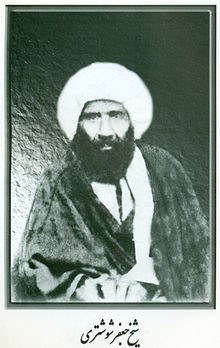Haj Sheikh Jafar Shoushtari
Haji Sheikh Jafar Shoushtari | |
|---|---|
 | |
| Born | 1814 or 1815 Shushtar, Iran |
| Died | 1885 |
| Nationality | Iranian |
| Academic work | |
| Notable works | Muthir al-Ahzan |
Haji Sheikh Jafar Shoushtari (1814/1815 – 1885) was a Persian Shia scholar from Shoushtar, Khuzestan Province, in modern-day Iran.
Biography[edit | edit source]
Haji Sheikh Jafar Shoushtari was born in the city of Shoushtar in 1230 AH/1814 or 1815 CE. He was the great-great-grandson of the famous Shia scholar Ali Al Najjar Shoushtari. In his early childhood, he migrated to Baghdad with his father and settled near the Shrine of Imams Musa al-Kadhim(AS) and Mohammad al-Taqi A(S), known by the name of Kadhimiya. After a visit back to his hometown, Shoushtar, he returned to Iraq to continue his studies in Karbala and Najaf. On the orders of Naser al-Din Shah, many Shia scholars requested him to stay in Tehran so that they could benefit from him. People like his sermons as they are very heart-touching and emotional. The Nasir al-Din would often disguise himself to come and listen to Sheikh Jafar Shoushtari’s lectures. The number of people who attended his sermons was so large that initially, the Marvi mosque assigned as the place for his lectures could not fit such a large audience. He was shifted to another, more prominent mosque. While returning to Iraq after paying a pilgrimage to the shrine of Imam Reza (AS) in Mashhad, Sheikh Jafar Shoushtari passed away on the journey.
He Taught many students who became prominent Shia scholars, including Mirza Mohammad Hamedani, Molla Ahmad Naraghi, and Sayyid Abdul Samad Jazayeri.
Teachers[edit | edit source]
He Studied under the following teachers
- Sheikh Mohammad Ale Yasin
- Sheikh Morteza Ansari
- Sheikh Mohammad Hossein Isfahani
- Sheikh Ali bin Jafar Kashef al Ghata
- Sheikh Hassan bin Jafar Kashef al Ghata
- Sheikh Mohammad Hossein Saheb Fosool
- Sheikh Ismail bin Asadollah Kazemi
- Sheikh Abdul Nabi Kazemi
- Sheikh Muhammad Hassan Najafi
Books[edit | edit source]
- Al Khasais al Hussainiya (The Attributes of Husain’s movement)
- Menhaj ul Irshad (The method of Guidance)
- Majales Al_Mavaez (Board of Sermons)
- Fawayed Al_Mashahed va Natayej Al Maqased (The benefits of viewer and the results of objectives)
- Usool al_deen (Principles of Religion)
- Dame ul Ayn (The teary Eye)
- Lawaeh Allawahayn (Rules and Regulations)
The attributes of Imam Hussain[edit | edit source]
Haji Sheikh Jafar Shoushtari, in his book “Al Khasais al-Hussainiya,” mentions the unique and special characteristics and attributes of Imam Hussain (AS). For example, he says that the pilgrimage to the Shrine of Imam Hussain has more reward than the pilgrimage to the living Imam. This attribute is exclusive to Imam Hussain (AS). Apart from outlining Imam’s (AS) attributes, Shoushtari compares them to the best of the Prophets. Shoushtari also lists Imam Hussain’s (AS) traits mentioned in the Quran.